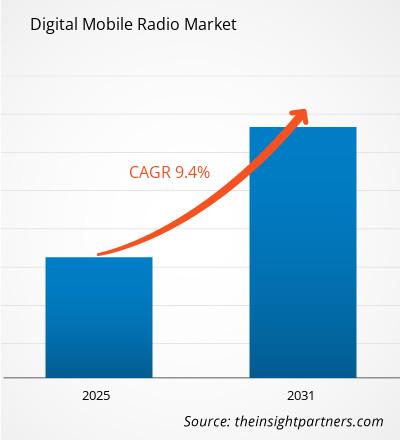Se espera que el mercado de radio móvil digital registre una CAGR del 9,4% entre 2025 y 2031, con un tamaño de mercado que se expandirá de US$ XX millones en 2024 a US$ XX millones en 2031.
El informe está segmentado por Nivel (Nivel 1, Nivel 2, Nivel 3); Tipo de producto (Portátil, Vehículo); Frecuencia (25 a 174 MHz, 200 a 512 MHz, Más de 700 MHz); Sector industrial (Aeroespacial y defensa, Comercial, Transporte, Petróleo y gas, Minería, Automotriz, Otros); Geografía (Norteamérica, Europa, Asia-Pacífico, Oriente Medio y África, Sudamérica y Centroamérica).
El análisis global se desglosa a nivel regional y por países principales. El informe ofrece el valor en USD para el análisis y los segmentos mencionados.
Propósito del Informe
El informe "Mercado de Radio Móvil Digital" de The Insight Partners busca describir el panorama actual y el crecimiento futuro, los principales factores impulsores, los desafíos y las oportunidades. Esto proporcionará información a diversos actores del sector, como:
- Proveedores/Fabricantes de Tecnología: Para comprender la dinámica cambiante del mercado y conocer las oportunidades potenciales de crecimiento, lo que les permitirá tomar decisiones estratégicas informadas.
- Inversores: Realizar un análisis exhaustivo de tendencias respecto a la tasa de crecimiento del mercado, las proyecciones financieras del mercado y las oportunidades que existen en toda la cadena de valor.
- Organismos reguladores: Regular las políticas y las actividades policiales en el mercado con el objetivo de minimizar el abuso, preservar la confianza de los inversores y defender la integridad y estabilidad del mercado.
Segmentación del mercado de radio móvil digital
Nivel
- Nivel 1
- Nivel 2
- Nivel 3
Tipo de producto
- Portátil de mano
- En el vehículo
Frecuencia
- 25 a 174 MHz
- 200 a 512 MHz
- Más de 700 MHz
Vertical de la industria
- Aeroespacial y defensa
- Comercial
- Transporte
- Petróleo y gas
- Minería
- Automotor
- Otros
Personalice este informe según sus necesidades
Obtendrá personalización en cualquier informe, sin cargo, incluidas partes de este informe o análisis a nivel de país, paquete de datos de Excel, así como también grandes ofertas y descuentos para empresas emergentes y universidades.
Mercado de radio móvil digital: Perspectivas estratégicas

- Obtenga las principales tendencias clave del mercado de este informe.Esta muestra GRATUITA incluirá análisis de datos, desde tendencias del mercado hasta estimaciones y pronósticos.
Factores que impulsan el crecimiento del mercado de la radio móvil digital
- Mayor demanda de comunicaciones fiables: La creciente necesidad de sistemas de comunicación fiables y seguros en diversos sectores, como la seguridad pública, el transporte y la defensa, es un factor clave del mercado de la radio móvil digital (DMR). A medida que las organizaciones buscan mejorar la eficiencia operativa y garantizar una comunicación eficaz durante emergencias, los sistemas DMR ofrecen características robustas como una calidad de audio mejorada, un mayor alcance y cifrado, lo que los hace esenciales para aplicaciones de misión crítica.
- Avances tecnológicos: Los continuos avances en la tecnología de radio móvil digital impulsan el crecimiento del mercado. Innovaciones como la mejora de la eficiencia del espectro, la interoperabilidad con otros sistemas de comunicación y las funcionalidades mejoradas, como el GPS y los servicios de datos, hacen que los sistemas DMR sean más atractivos para los usuarios. Estos avances permiten a las organizaciones aprovechar los DMR para diversas aplicaciones, lo que aumenta su adopción en todos los sectores.
- Cumplimiento normativo y estandarización: La implementación de estrictas regulaciones y estándares para los sistemas de comunicación está impulsando el mercado de DMR. Los gobiernos y los organismos del sector exigen el uso de protocolos de comunicación estandarizados para mejorar la interoperabilidad, la seguridad y la eficiencia. A medida que las organizaciones se esfuerzan por cumplir con estas regulaciones, se prevé un aumento en la demanda de sistemas DMR que cumplan con estándares específicos, lo que impulsará aún más el crecimiento del mercado.
Tendencias futuras del mercado de radio móvil digital
- Migración a plataformas digitales: La tendencia de migrar de sistemas de comunicación analógicos a digitales está cobrando impulso en el mercado de la radio móvil digital. Las organizaciones reconocen cada vez más las ventajas de la tecnología digital, como una mejor calidad de audio, funciones mejoradas y mayor eficiencia. A medida que los usuarios migran a plataformas digitales, se prevé un aumento en la demanda de sistemas DMR que se integren perfectamente con la infraestructura existente y proporcionen capacidades avanzadas.
- Enfoque en funciones de seguridad mejoradas: A medida que las ciberamenazas y las preocupaciones de seguridad se vuelven más frecuentes, se hace cada vez más hincapié en la incorporación de funciones de seguridad mejoradas en los sistemas de radio móvil digital. Los fabricantes priorizan el desarrollo de protocolos de cifrado, comunicaciones seguras y mecanismos de autenticación avanzados para proteger la información confidencial. Esta tendencia es especialmente importante para sectores como la seguridad pública y la defensa, donde la comunicación segura es crucial para la integridad y la seguridad operativas.
Oportunidades del mercado de radio móvil digital
- Expansión empresarial en regiones en desarrollo: El mercado de la radio móvil digital presenta importantes oportunidades en las economías emergentes, donde el desarrollo de infraestructura y la urbanización avanzan rápidamente. A medida que los países invierten en sistemas de comunicación modernos para mejorar la seguridad pública y la eficiencia operativa, crece la demanda de soluciones DMR. Las empresas que expandan estratégicamente su presencia en estas regiones pueden aprovechar la creciente necesidad de sistemas de comunicación fiables.
- Integración con el IoT y las tecnologías inteligentes: La convergencia de los sistemas de radio móvil digital con el Internet de las Cosas (IoT) y las tecnologías inteligentes ofrece prometedoras oportunidades de innovación. La integración de DMR con aplicaciones del IoT puede mejorar la funcionalidad, permitiendo el intercambio de datos en tiempo real, la monitorización remota y un mejor conocimiento de la situación. Esta integración puede impulsar el desarrollo de soluciones de comunicación avanzadas para diversos sectores, como la logística, la sanidad y las ciudades inteligentes.
Perspectivas regionales del mercado de radio móvil digital
Los analistas de Insight Partners han explicado detalladamente las tendencias y los factores regionales que influyen en el mercado de radio móvil digital durante el período de pronóstico. Esta sección también analiza los segmentos y la geografía del mercado de radio móvil digital en Norteamérica, Europa, Asia Pacífico, Oriente Medio y África, y Sudamérica y Centroamérica.

- Obtenga los datos regionales específicos para el mercado de radio móvil digital
Alcance del informe del mercado de radio móvil digital
| Atributo del informe | Detalles |
|---|---|
| Tamaño del mercado en 2024 | US$ XX millones |
| Tamaño del mercado en 2031 | US$ XX millones |
| CAGR global (2025-2031) | 9,4% |
| Datos históricos | 2021-2023 |
| Período de pronóstico | 2025-2031 |
| Segmentos cubiertos | Por nivel
|
| Regiones y países cubiertos | América del norte
|
| Líderes del mercado y perfiles de empresas clave |
|
Densidad de actores del mercado de radio móvil digital: comprensión de su impacto en la dinámica empresarial
El mercado de la radio móvil digital está creciendo rápidamente, impulsado por la creciente demanda de los usuarios finales debido a factores como la evolución de las preferencias de los consumidores, los avances tecnológicos y una mayor comprensión de las ventajas del producto. A medida que aumenta la demanda, las empresas amplían su oferta, innovan para satisfacer las necesidades de los consumidores y aprovechan las tendencias emergentes, lo que impulsa aún más el crecimiento del mercado.
La densidad de actores del mercado se refiere a la distribución de empresas o compañías que operan en un mercado o sector en particular. Indica cuántos competidores (actores del mercado) hay en un mercado determinado en relación con su tamaño o valor total.
Las principales empresas que operan en el mercado de radio móvil digital son:
- Tecnologías BK
- Tecnologías Harris Inc.
- Corporación de comunicaciones Hytera Ltd.
- Leonardo SpA
- Motorola Solutions Inc.
Descargo de responsabilidad : Las empresas enumeradas anteriormente no están clasificadas en ningún orden particular.

- Obtenga una descripción general de los principales actores clave del mercado de radio móvil digital
Puntos clave de venta
- Cobertura integral: el informe cubre de manera integral el análisis de productos, servicios, tipos y usuarios finales del mercado de radio móvil digital, proporcionando un panorama holístico.
- Análisis de expertos: el informe se compila con base en el conocimiento profundo de expertos y analistas de la industria.
- Información actualizada: El informe asegura relevancia comercial debido a su cobertura de información reciente y tendencias de datos.
- Opciones de personalización: este informe se puede personalizar para satisfacer los requisitos específicos del cliente y adaptarse adecuadamente a las estrategias comerciales.
Por lo tanto, el informe de investigación sobre el mercado de radio móvil digital puede ayudar a descifrar y comprender el panorama de la industria y sus perspectivas de crecimiento. Si bien existen algunas preocupaciones válidas, las ventajas generales de este informe tienden a superar las desventajas.
- Análisis histórico (2 años), año base, pronóstico (7 años) con CAGR
- Análisis PEST y FODA
- Tamaño del mercado Valor/volumen: global, regional, nacional
- Industria y panorama competitivo
- Conjunto de datos de Excel


- Data Annotation Tools Market
- Maritime Analytics Market
- Radiopharmaceuticals Market
- Excimer & Femtosecond Ophthalmic Lasers Market
- Single-Use Negative Pressure Wound Therapy Devices Market
- Malaria Treatment Market
- Customer Care BPO Market
- Airline Ancillary Services Market
- Foot Orthotic Insoles Market
- Terahertz Technology Market

Report Coverage
Revenue forecast, Company Analysis, Industry landscape, Growth factors, and Trends

Segment Covered
This text is related
to segments covered.

Regional Scope
North America, Europe, Asia Pacific, Middle East & Africa, South & Central America

Country Scope
This text is related
to country scope.
Preguntas frecuentes
Some of the customization options available based on the request are an additional 3-5 company profiles and country-specific analysis of 3-5 countries of your choice. Customizations are to be requested/discussed before making final order confirmation# as our team would review the same and check the feasibility
The report can be delivered in PDF/PPT format; we can also share excel dataset based on the request
Focus on Sustainability and Energy Efficiency is anticipated to play a significant role in the global Digital Mobile Radio Market in the coming years
Growing demand for reliable communication and Advances in technology are the major factors driving the Digital Mobile Radio Market
The Digital Mobile Radio Market is estimated to witness a CAGR of 9.4% from 2023 to 2031
Trends and growth analysis reports related to Electronics and Semiconductor : READ MORE..
1. BK Technologies
2. Harris Technologies Inc.
3. Hytera Communications Corporation Ltd.
4. Leonardo SpA
5. Motorola Solutions Inc.
6. MCS Digital
7. Radiodata GmbH
8. Sigtech Wireless Technologies
9. Simoco Wireless Solutions Limited
10. Tait Ltd.
The Insight Partners performs research in 4 major stages: Data Collection & Secondary Research, Primary Research, Data Analysis and Data Triangulation & Final Review.
- Data Collection and Secondary Research:
As a market research and consulting firm operating from a decade, we have published and advised several client across the globe. First step for any study will start with an assessment of currently available data and insights from existing reports. Further, historical and current market information is collected from Investor Presentations, Annual Reports, SEC Filings, etc., and other information related to company’s performance and market positioning are gathered from Paid Databases (Factiva, Hoovers, and Reuters) and various other publications available in public domain.
Several associations trade associates, technical forums, institutes, societies and organization are accessed to gain technical as well as market related insights through their publications such as research papers, blogs and press releases related to the studies are referred to get cues about the market. Further, white papers, journals, magazines, and other news articles published in last 3 years are scrutinized and analyzed to understand the current market trends.
- Primary Research:
The primarily interview analysis comprise of data obtained from industry participants interview and answers to survey questions gathered by in-house primary team.
For primary research, interviews are conducted with industry experts/CEOs/Marketing Managers/VPs/Subject Matter Experts from both demand and supply side to get a 360-degree view of the market. The primary team conducts several interviews based on the complexity of the markets to understand the various market trends and dynamics which makes research more credible and precise.
A typical research interview fulfils the following functions:
- Provides first-hand information on the market size, market trends, growth trends, competitive landscape, and outlook
- Validates and strengthens in-house secondary research findings
- Develops the analysis team’s expertise and market understanding
Primary research involves email interactions and telephone interviews for each market, category, segment, and sub-segment across geographies. The participants who typically take part in such a process include, but are not limited to:
- Industry participants: VPs, business development managers, market intelligence managers and national sales managers
- Outside experts: Valuation experts, research analysts and key opinion leaders specializing in the electronics and semiconductor industry.
Below is the breakup of our primary respondents by company, designation, and region:

Once we receive the confirmation from primary research sources or primary respondents, we finalize the base year market estimation and forecast the data as per the macroeconomic and microeconomic factors assessed during data collection.
- Data Analysis:
Once data is validated through both secondary as well as primary respondents, we finalize the market estimations by hypothesis formulation and factor analysis at regional and country level.
- Macro-Economic Factor Analysis:
We analyse macroeconomic indicators such the gross domestic product (GDP), increase in the demand for goods and services across industries, technological advancement, regional economic growth, governmental policies, the influence of COVID-19, PEST analysis, and other aspects. This analysis aids in setting benchmarks for various nations/regions and approximating market splits. Additionally, the general trend of the aforementioned components aid in determining the market's development possibilities.
- Country Level Data:
Various factors that are especially aligned to the country are taken into account to determine the market size for a certain area and country, including the presence of vendors, such as headquarters and offices, the country's GDP, demand patterns, and industry growth. To comprehend the market dynamics for the nation, a number of growth variables, inhibitors, application areas, and current market trends are researched. The aforementioned elements aid in determining the country's overall market's growth potential.
- Company Profile:
The “Table of Contents” is formulated by listing and analyzing more than 25 - 30 companies operating in the market ecosystem across geographies. However, we profile only 10 companies as a standard practice in our syndicate reports. These 10 companies comprise leading, emerging, and regional players. Nonetheless, our analysis is not restricted to the 10 listed companies, we also analyze other companies present in the market to develop a holistic view and understand the prevailing trends. The “Company Profiles” section in the report covers key facts, business description, products & services, financial information, SWOT analysis, and key developments. The financial information presented is extracted from the annual reports and official documents of the publicly listed companies. Upon collecting the information for the sections of respective companies, we verify them via various primary sources and then compile the data in respective company profiles. The company level information helps us in deriving the base number as well as in forecasting the market size.
- Developing Base Number:
Aggregation of sales statistics (2020-2022) and macro-economic factor, and other secondary and primary research insights are utilized to arrive at base number and related market shares for 2022. The data gaps are identified in this step and relevant market data is analyzed, collected from paid primary interviews or databases. On finalizing the base year market size, forecasts are developed on the basis of macro-economic, industry and market growth factors and company level analysis.
- Data Triangulation and Final Review:
The market findings and base year market size calculations are validated from supply as well as demand side. Demand side validations are based on macro-economic factor analysis and benchmarks for respective regions and countries. In case of supply side validations, revenues of major companies are estimated (in case not available) based on industry benchmark, approximate number of employees, product portfolio, and primary interviews revenues are gathered. Further revenue from target product/service segment is assessed to avoid overshooting of market statistics. In case of heavy deviations between supply and demand side values, all thes steps are repeated to achieve synchronization.
We follow an iterative model, wherein we share our research findings with Subject Matter Experts (SME’s) and Key Opinion Leaders (KOLs) until consensus view of the market is not formulated – this model negates any drastic deviation in the opinions of experts. Only validated and universally acceptable research findings are quoted in our reports.
We have important check points that we use to validate our research findings – which we call – data triangulation, where we validate the information, we generate from secondary sources with primary interviews and then we re-validate with our internal data bases and Subject matter experts. This comprehensive model enables us to deliver high quality, reliable data in shortest possible time.

 Obtenga una muestra gratuita de este informe
Obtenga una muestra gratuita de este informe